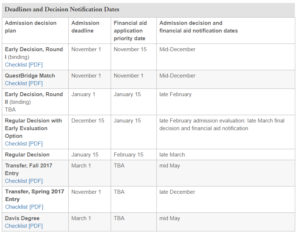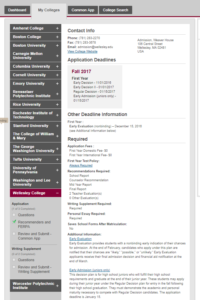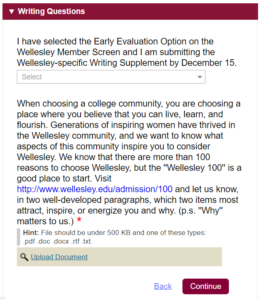The Ultimate Guide to Applying to Wellesley
As one of the best-known women’s colleges and best-regarded private liberal arts colleges in the United States, Wellesley College has been responsible for the academic and career development of generations of women. Life on campus is close-knit and steeped in almost a century and a half of tradition, from fun pastimes like “hoop rolling” to a serious commitment to issues affecting women.
With its dedication to academic excellence and the opportunities it offers its students, along with the special benefits that some people find in single-gender educational programs, looking into Wellesley is definitely worth your time if you’re a female applicant and think you would flourish in a liberal-arts college.
Wellesley’s notable alumni include important political figures, groundbreaking scientists, and quite a few successful business leaders, forming a powerful and wide-ranging network of professional women. Are you interested in becoming one of these “smart, singular women”? Read on for more details about attending Wellesley and advice for the application process from the CollegeVine team.
Introducing Wellesley
Wellesley College is located in the suburban setting of Wellesley, Massachusetts, outside of Boston, on a 500-acre campus whose beauty has been lauded by such luminaries as Frederick Law Olmstead, the designer of Central Park. It’s a prestigious and well-known school; according to the popular U.S. News and World Reports rankings, Wellesley is tied for the #4 ranking in the United States in the National Liberal Arts Colleges category.
As you likely already know, Wellesley was founded in 1870 as a women’s college, and admission is restricted to women to this day. Wellesley is one of the Seven Sisters colleges, a group of women’s colleges in the northeastern United States that were founded in the mid-19th century, and has historically been a strong advocate for women’s education. Currently, Wellesley has the largest endowment of any women’s college in the world.
Some men do enroll in courses at Wellesley as a result of the college’s cross-registration agreements with various coeducational schools. Wellesley students can take advantage of these agreements to take courses at MIT, Brandeis, and other schools in the Boston area. In addition, Wellesley participates in exchange programs that allow students to spend a year at another participating college, typically other smaller colleges in the Northeast such as Amherst and Dartmouth.
At present, Wellesley is home to approximately 2,300 undergraduate students, whose origins represent all 50 states in the U.S. as well as 80 additional countries. All students at Wellesley are undergraduates, and all will earn the Bachelor of Arts degree when they graduate. Students can currently choose from over 54 academic majors, some of which are interdisciplinary, or can get special permission to create their own majors. The most popular majors at Wellesley are economics, psychology, and English.
In addition to their majors, students at Wellesley must complete a number of distribution requirements, take an expository writing course in their first year, and meet several other criteria. Wellesley students can choose to undertake academic minors as well, but this is not required. Nearly half of Wellesley students choose to study abroad at some point during their college years.
Most students at Wellesley live on campus in residence halls. Outside of the classroom, Wellesley students participate in over 150 student groups, including cultural and religious groups, performing arts groups, and political organizations. Boston, with its additional resources and entertainment options, is easily accessible by bus, train, car, or the free weekday shuttle that runs between Wellesley and MIT.
Wellesley Admissions Information
Admissions to Wellesley are competitive, with acceptance rates hovering around 30% in recent years. For the class of 2020, Wellesley accepted approximately 28% of applicants, out of a pool of 4,888 total applications. Again, admission to Wellesley is restricted to women. This includes transgender women as well as students who were assigned female at birth and identify as nonbinary.
Admissions applications are considered by Wellesley’s Board of Admissions, which is comprised of faculty, administrative staff, and students in addition to admissions staffers. The Board of Admissions considers a range of factors when evaluating applicants, including academic achievement, but also more personal measures such as recommendations and special talents. Each year, the applicant pool is quite strong, and not all qualified applicants can be offered admission.
In addition to first-year applicants, Wellesley accepts transfer applications from students who have completed between two and four semesters at other colleges and universities in the United States. (Students who have started a degree program at a school outside the United States are not eligible to apply as transfers, and must apply as first-years.) Transfers may apply to enter in either the fall semester or the spring semester.
Transfer applicants who are over 24 years old, who are parents, or who are veterans may apply through the Elisabeth Kaiser David Degree Program, which is specifically tailored to students who don’t fit the mold of the average college student due to their age or life experiences.
Paying for Wellesley
As of the 2016-2017 school year, tuition at Wellesley College costs $48,510 per year, and the total estimated billed cost of attendance for a student who lives on campus is $63,916 for the year. This does not include the cost of books, personal expenses, and travel to and from Wellesley, which will vary from student to student. Admission to Wellesley is need-blind for applicants who are U.S. citizens or permanent residents. This means that these students’ applications will be evaluated regardless of their financial ability to pay for college.
Wellesley also commits to providing need-based financial aid that meets 100% of the demonstrated need of all domestic students who apply for it. Close to 60% of Wellesley students receive financial aid to assist with the cost of their education. In order to apply for financial aid, students from the United States must submit the FAFSA and the CSS Profile, and must also submit their parents’ tax forms for verification. Domestic students can get an estimate of their likely cost of attendance by using Wellesley’s My inTuition cost estimator tool, though these estimates are non-binding for Wellesley.
As we’ll discuss later in this post, Wellesley has quite a few different admissions application deadlines, including several early application options. Therefore, there are a range of due dates for financial aid materials, depending on how you’re applying. The following chart from the Wellesley College website shows the financial aid application due dates and notification dates for each application option:
Financial aid options for international students at Wellesley differ significantly from financial aid options for domestic students. First, admission to Wellesley is need-aware for international applicants. This means that the Board of Admissions will have access to the applicant’s financial aid materials, and the student’s ability to pay for college may play a role in their admission decision. Second, financial aid availability at Wellesley is limited for international students, which has led to stricter policies regarding how financial aid is allocated.
As with domestic students, international students who are admitted to Wellesley are guaranteed financial aid that meets 100% of their demonstrated need. In combination with the need-aware admissions policy for international students, this essentially means that Wellesley will only accept a certain number of international students with financial need in order to stay within their budget. In addition, international students must apply for financial aid through the CSS Profile with their admissions application (according to the deadlines listed above) if they intend to do so at all; no later financial aid applications are considered.
The Wellesley Application
The majority of students applying to Wellesley will apply through the Common Application, or Common App. In the future, Wellesley intends to also accept applications through the Coalition Application, another application system that works with multiple schools, but this option is still in development and will not be available until the summer of 2017.
In order to apply using the Common App, you’ll first need to create a Common App profile online, fill out the questions asked by the Common App itself, and select Wellesley as one of your schools. For instructions on how to approach the Common App, take a look at our User’s Guide to the Common App, as well as our targeted posts on how to fill out the sections about your demographic information, citizenship, academics, activities, awards, and more.
In addition to the basic questions on the Common App, you’ll need to complete the Wellesley-specific Common App supplement. Later in this post, we’ll go over the questions that will appear on the Wellesley supplement for the 2016-2017 application season.
In terms of application deadlines, Wellesley has four different decision plans for incoming first-years, as described below:
- Early Decision I: ED I students submit their applications by November 1st. The ED I option is binding, meaning that you must attend Wellesley if you are accepted under this plan.
- Early Decision II: ED II students submit their applications by January 1. Like ED I, the ED II option is binding. This option is a recent addition to Wellesley’s admissions program.
- Regular Decision: RD students submit their applications by January 15th. This is the most traditional application option.
- Regular Decision with Early Evaluation Option: RD students who wish to use the Early Evaluation option submit their applications by December 15th. In late February, these students receive notification of whether their chances of acceptance are “likely,” “possible,” or “unlikely.” Their final admissions decisions are released in late March. The RD option with Early Evaluation is not binding.
Wellesley’s admissions website contains additional information about when additional documents, standardized test scores, and the like must be submitted under each application timeline. (We’ll go over these requirements later in this post.) Visit the CollegeVine blog for more information about Early Decision I and II timelines and how to choose which plan is right for you.
In addition to these decision plans, Wellesley’s application website references the Accelerated Admission process for high-school juniors. This option is intended for students who will graduate after only three years of high school and who have transcripts and achievements similar to those of high-school seniors. Under this decision plan, you would submit your application according to the Regular Decision timeline, but a year earlier than most students. If you’re interested in this option, you’ll first need to consult with your guidance counselor and other school officials about whether you will be able to graduate early.
Some students may apply to Wellesley through the QuestBridge National College Match program, which is designed to improve college access for low-income students. The deadline for the QuestBridge application is November 1st, but in order to make use of the QuestBridge application process for Wellesley, a prospective applicant must have already applied separately to the QuestBridge program and been named a Finalist in that program. Further instructions on how to apply to Wellesley and other schools through QuestBridge can be found on the QuestBridge website.
Common App Supplement Instructions
Once you have set up your Common App profile and added Wellesley as one of your colleges, you’ll need to fill out Wellesley’s Common App supplement. To access this supplement, navigate to the My Colleges tab within your Common App account and click on Wellesley. You’ll see the following screen, shown in a screenshot taken from our sample student’s application:
First, you’ll need to complete a number of application questions specific to Wellesley. To access these questions, look under the Wellesley College tab on the left side. Under the heading “Application”, click on “Questions.” You’ll open up the following screen:
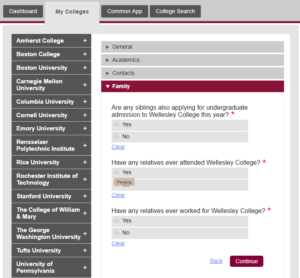
As you can see, you have four sections of questions to complete: General, Academics, Contacts, and Family. We’ll go over the questions you’ll find in each of these sections below.
For the General section, you’ll need to complete the following questions:
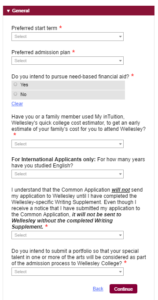
- Preferred start term: Choose your preferred start term (likely Fall 2017) from the drop-down menu.
- Preferred admission plan: Choose Early Decision I, Early Decision II, Regular Decision, or Early Admission (juniors only) from the drop-down menu. If you select Regular Decision, you will be prompted to answer a further question: If you are applying as a Regular Decision applicant do you wish to receive an Early Evaluation from the Board of Admission and notification of the probability of your admission as “likely,” possible,” or “unlikely” in late February? Answer yes in the drop-down menu if you are applying by December 15th and would like an early evaluation; otherwise, answer no.
- Do you intend to pursue need-based financial aid?: Select yes if you intend to apply for financial aid from Wellesley, or no if you do not intend to do so.
- Have you or a family member used My inTuition, Wellesley’s quick college cost estimator, to get an early estimate of your family’s cost for you to attend Wellesley?: If you or one of your family members has used My inTuition, select yes; otherwise, select no.
- For International Applicants only: For how many years have you studied English?: If you are an international applicant, select the number of years you have spent studying English from the drop-down menu.
- I understand that the Common Application will not send my application to Wellesley until I have completed the Wellesley-specific Writing Supplement. Even though I receive a notice that I have submitted my application to the Common Application, it will not be sent to Wellesley without the completed Writing Supplement.: While you can technically respond no to this question, you should answer it in the affirmative. Select “Yes, I understand that I must submit a Wellesley-specific Writing Supplement for my application to be considered complete by Wellesley.” in the drop-down menu.
- Do you intend to submit a portfolio so that your special talent in one or more of the arts will be considered as part of the admission process to Wellesley College?: Choose yes or no from the drop-down menu, but first, check out the CollegeVine blog for more information about whether submitting an arts supplement is a good idea for you.
For the Academics section, you’ll need to respond to the following question about your academic interests:
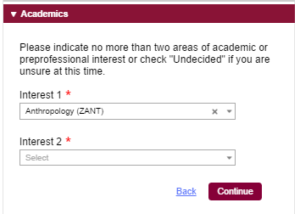
The question reads, Please indicate no more than two areas of academic or preprofessional interest or check “Undecided” if you are unsure at this time. You can choose from two drop-down menus to indicate your first and second choices of academic or preprofessional interest.
Don’t worry— your answers to this question don’t commit you to any particular academic track. You can answer that you’re undecided if you really can’t decide, but don’t stress out too much about putting down the “right” answers here. It’s more important that the admissions office sees that you’ve put some thought into what you’d like to study.
For the Contacts section, you’ll need to complete the following questions about your previous contacts with Wellesley College:
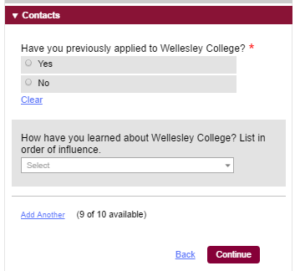
- Have you previously applied to Wellesley College?: Select yes or no. If you select yes, you’ll be prompted to provide the month and year you previously applied to Wellesley.
- How have you learned about Wellesley College? List in order of influence.: Select the way you learned about Wellesley from the drop-down menu. Click “Add Another” to add more ways you learned about Wellesley, and use the arrows that will appear to put them in order. This is not an important factor in your admissions decision by any means, but it does help the college to determine which of their outreach methods are working.
For the Family section, you’ll need to complete the following questions about your family connections to Wellesley College:
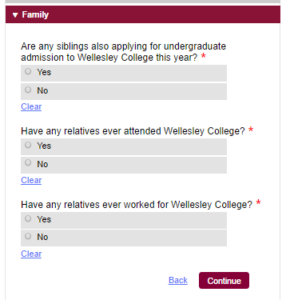
- Are any siblings also applying for undergraduate admission to Wellesley College this year?: Select yes if you have a sibling or step-sibling who is also applying to Wellesley this year; otherwise, select no. If you select yes, you will be prompted to enter their name(s) and relationship(s) to you. You can add up to five siblings if necessary.
- Have any relatives ever attended Wellesley College?: Select yes if you have any relatives who have attended Wellesley; otherwise, select no. If you select yes, you will be prompted to enter their name(s), relationship(s) to you, and the number of degrees they (each) received. You can add up to five relatives. Since legacies can be a factor in admissions decisions, it’s important that you answer this question accurately.
- Have any relatives ever worked at Wellesley College?: Select yes if you have any relatives who have been employed by Wellesley; otherwise, select no. If you select yes, you will be prompted to enter their name(s), relationship(s) to you, and job information. You can add up to five relatives.
Once you’ve completed Wellesley’s supplemental Common App questions, you’ll need to move on to Wellesley’s writing supplement. You can access the writing supplement by looking at the Writing Supplement section below Wellesley’s name on the left side, and clicking on Questions. When you do so, you’ll see the following:
First of all, you may need to respond to the statement at the top: “I have selected the Early Evaluation Option on the Wellesley Member Screen and I am submitting the Wellesley-specific Writing Supplement by December 15.” You should only respond to this question (by choosing the only option available in the drop-down menu) if you are, in fact, selecting the Early Evaluation Option, which we describe elsewhere in this post. If you are applying under one of the other admissions plans, you don’t need to worry about this question.
Finally, you’ll respond to the following essay prompt:
“When choosing a college community, you are choosing a place where you believe that you can live, learn, and flourish. Generations of inspiring women have thrived in the Wellesley community, and we want to know what aspects of this community inspire you to consider Wellesley. We know that there are more than 100 reasons to choose Wellesley, but the “Wellesley 100” is a good place to start. Visit the Wellesley 100 and let us know, in two well-developed paragraphs, which two items most attract, inspire, or energize you and why. (PS: “Why” matters to us.)”
In order to answer this question, you’ll upload a document in one of the required formats instead of typing into a text box. For a detailed breakdown of how to craft a response to this essay question, take a look at the CollegeVine blog post “How to Write the Wellesley College Application Essays 2016-17.”
Interviewing for Wellesley
Interviews are not technically required as part of the regular Wellesley College admission application for most first-year or transfer students, but they are strongly recommended for all applicants who have the opportunity. Students must reach out to Wellesley themselves to request interviews in a process that we’ll go over below. Interview opportunities for international applicants are very limited and only available in certain locations; however, applicants will not be penalized if it’s not possible for them to arrange an interview.
Applicants can choose to interview either on-campus at Wellesley with a current Wellesley senior, or off-campus with a Wellesley alumna who lives in their area, if one is available. Each applicant must choose either one or the other interview type, and can only have one interview. Whether it occurs on or off the campus, the interview will help Wellesley to confirm the information you provided in your application, and also to get a more personal perspective on whether you would be a positive addition to the Wellesley community. The interview also provides you with the opportunity to speak with the alumna about her experience at Wellesley and ask any questions you may have.
Those applicants who are able to visit Wellesley and interview in person should schedule an interview, among other activities, by filling out Wellesley’s campus visit registration form. Applicants who cannot physically come to Wellesley should request an off-campus interview by filling out Wellesley’s Off-Campus Interview Form, which will become available later in September. Interview requests must be made by the Common App due date for whichever decision plan you have chosen, so you’ll need to make that decision before you request an interview.
If you’re interested in Wellesley, you can find some possible questions that you might be asked at your interview on this webpage. However, every interview will be different, and interviews will generally take the form of a relatively informal conversation in which you can learn more about Wellesley and Wellesley can learn more about you. Check out the CollegeVine blog for additional information about how to prepare for your interview, what to do, and what not to do.
Other Wellesley Application Requirements
In addition to your basic Common App application and the Wellesley supplement, you’ll need to submit the following documents to be considered for admission:
- Official transcript, sent by your school.
- Letter of recommendation, completed by your guidance counselor or other school official.
- Two additional letters of recommendation, completed by teachers of academic subjects.
- Official test scores either for the SAT plus 2 SAT II subject tests, OR for the ACT, requested by you and sent directly to Wellesley by the testing organizations.
In addition, applicants who wish to apply for financial aid should do so by the deadlines listed earlier in this post. Students who apply through the QuestBridge program may have slightly different application procedures, and are encouraged to follow any instructions they receive from QuestBridge.
You may have noticed that there’s no application fee listed here. It is indeed free to apply to Wellesley through the Common App for both domestic and international students— no fee waiver is required. However, students who are accepted will need to submit an enrollment deposit of $300 to secure their places in the matriculating class.
Hearing Back from Wellesley
ED I and II applicants to Wellesley may either be accepted, rejected, or deferred by the college when they receive their ED decisions. Remember, both ED I and ED II are binding, so if you are accepted to Wellesley under either of these programs, you must attend Wellesley.
Students who apply to Wellesley under the ED I option will receive their admissions decisions earliest, in mid-December. They must confirm their attendance and submit their enrollment deposits by January 5th if they are accepted. ED II applicants receive their admissions decisions in late February, and must confirm their attendance and submit their deposits by March 7th if they are accepted.
If you are denied admission to Wellesley in the ED I or ED II round, you may not reapply during the same application cycle. For example, if you were rejected in the ED I round, you would be prohibited from applying in the ED II or RD rounds. Since Wellesley does consider transfer applicants, you might be able to transfer to Wellesley later in your college career.
If you are deferred in one of the ED rounds, however, you still have a chance at attending Wellesley as a first-year in the class in which you originally applied. We’ll go over what deferral means for you in the next section of this post.
RD applicants receive their admissions decisions in late March. Those RD applicants who choose the Early Evaluation option, as discussed above, receive an indication of whether their acceptance to Wellesley is “likely,” “possible,” or “unlikely” in late February. Early Evaluation applicants receive their official admissions decisions in late March along with the rest of the RD applicant pool. All RD applicants must make a decision, respond to Wellesley, and submit their enrollment deposits by May 1st.
If you decide to apply to Wellesley through the RD with Early Evaluation process, you’ll need to keep your expectations reasonable. While this program can be helpful for applicants, it’s very important to keep in mind that this early evaluation is in no way binding on Wellesley’s part. A “likely” evaluation is not an acceptance by any means, and if you receive one, you should definitely still move forward with your other applications as well.
If you are accepted to Wellesley under any of the application options, you will respond to your offer of admission via the Wellesley application portal by the date given for that application option. There, you’ll officially respond “yes” or “no” to the offer and answer a few additional questions. Wellesley requires each student to submit a $300 enrollment deposit along with their response if they intend to attend Wellesley.
Deferrals and the Waitlist at Wellesley
For applicants in both the ED I pool and the ED II pool at Wellesley, deferral is always a possibility. If you are deferred in either the ED I or the ED II round, your application will be reevaluated with the RD applicant pool. (In other words, deferred ED I applicants will not be considered in the ED II pool, but deferred all the way to the RD pool.) At this point, you’ll no longer be bound by your ED agreement; if Wellesley accepts you from the RD pool, you will no longer be contractually required to attend.
Deferred applicants have some options in terms of maximizing their chances of admission. If you’re deferred, you can write a letter to your admissions officer reiterating your interest in and enthusiasm for Wellesley. You should include any new information about your achievements that didn’t make it onto your ED application, such as higher grades or test scores, additional activities or awards, and possibly even a new letter of recommendation. While there are no guarantees that you will be admitted in the RD round, this is an opportunity to improve whichever parts of your application may have been weakest.
When RD admissions decisions are made, some students are waitlisted. These students may be accepted into the matriculating class, depending on whether spots in the class become available. If you choose to remain on the waitlist, you may hear back from Wellesley after the May 1st response deadline; most waitlist acceptances at Wellesley are made in the third week of May, and the process is usually concluded by the end of June. You can learn more about Wellesley’s waitlist practices from this FAQ.
If you’re waitlisted at Wellesley, you should definitely start making plans to attend one of your other college options, including making a deposit if that school requires it. Wellesley only admitted 30 waitlisted students to the class of 2020, for an acceptance rate of 4%, so your chances of waitlist admission are quite low. However, as for a deferred applicant, it doesn’t hurt to also write a letter and inform the admissions office of any positive changes in your record.
Are you interested in applying to Wellesley? Still searching for the school that fits you best? CollegeVine can help. Visit our blog for more advice on choosing a college, crafting your application, and navigating the often-confusing world of college admissions.
Curious about your chances of acceptance to your dream school? Our free chancing engine takes into account your GPA, test scores, extracurriculars, and other data to predict your odds of acceptance at over 500 colleges across the U.S. We’ll also let you know how you stack up against other applicants and how you can improve your profile. Sign up for your free CollegeVine account today to get started!
